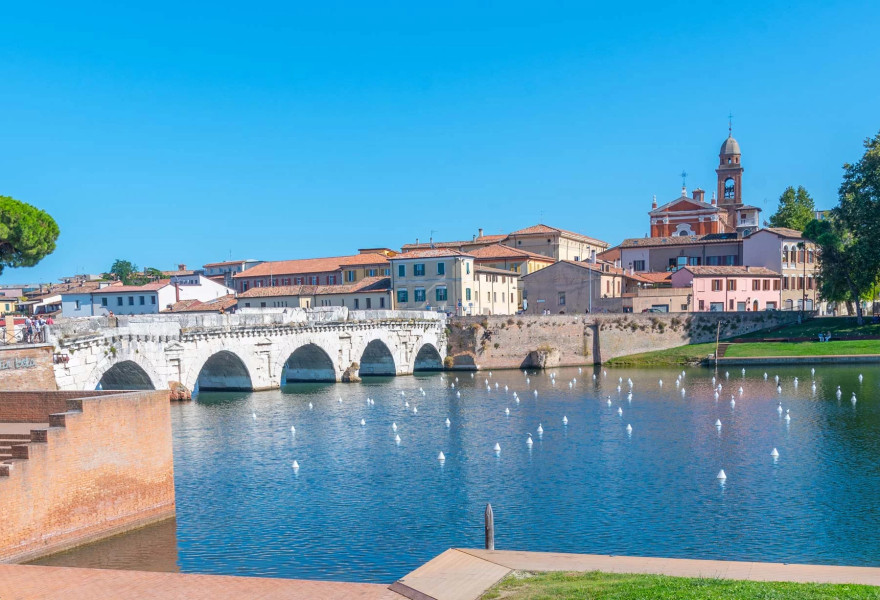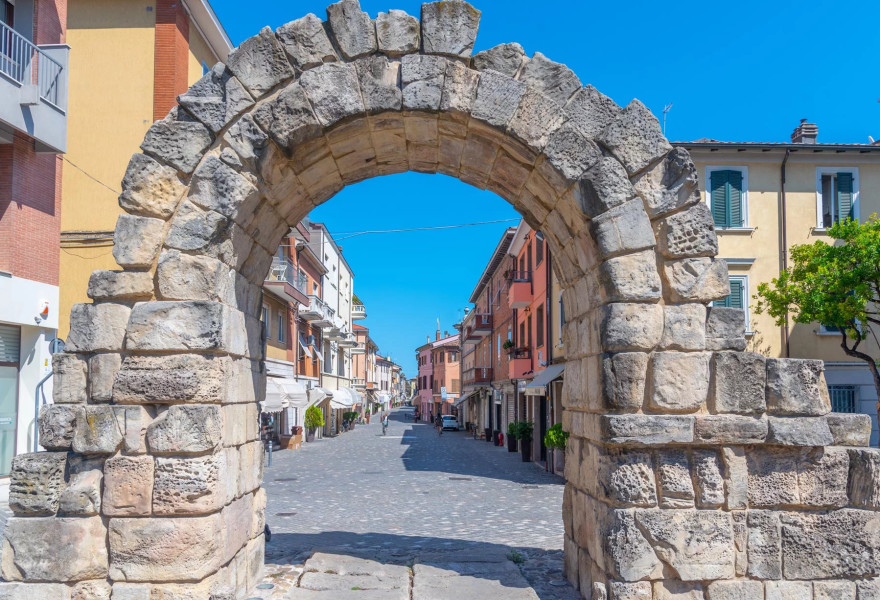Weekend in Rimini – 4-Star Hotel Offers

Rimini was founded by the Romans in 268 BC as a colony and became a Municipium in 90 BC. In 359, it hosted an important council called by Emperor Constantius II. Conquered by the Goths, it later became part of the Byzantine Exarchate under the Eastern Roman Empire. It passed to the Lombards and then came under papal control in the 8th century. In 1157, it gained municipal autonomy from Frederick Barbarossa and the Pope. Between the 13th and 16th centuries, it flourished under the rule of the Malatesta family, patrons of the arts who transformed Rimini into a cultural and artistic hub. It was later governed by Cesare Borgia and the Republic of Venice before returning to the Papal States. In 1860, it played a key role in the patriotic movements that led to its annexation to the Kingdom of Italy.
A symbol of the city along with the Tiberius Bridge, it is the oldest surviving Roman arch in the world. Built by Emperor Augustus in 27 B.C., it marked the end of the Via Flaminia which connected Rimini to Rome. Its rich decorative features reflect strong political and propagandistic symbolism. The archway is so wide it could not be fitted with gates—symbolizing the Augustan peace (Pax Augusta) following years of civil war.
Address: Corso d'Augusto

An extraordinary archaeological site dating back to the 2nd century A.D. More than 150 surgical instruments were discovered here, once belonging to a Roman military doctor—making this one of the most significant archaeological sites in Europe. Fine floor mosaics and remarkably preserved rooms tell the story of daily life and ancient medical excellence.
Address: Piazza Ferrari

Built with Istrian stone like the Arch of Augustus, construction began under Emperor Augustus in 14 A.D. and was completed by his successor Tiberius in 21 A.D. It marks the beginning of both the Via Emilia (connecting Rimini to Piacenza) and the Via Popilia (connecting Rimini to the Venice area).
Address: at the end of Corso d'Augusto

Commissioned by Sigismondo Malatesta in 1446, the church features a façade by Leon Battista Alberti. Inside are works by Agostino di Duccio, a Giottesque crucifix, an altar by Vasari, and a fresco by Piero della Francesca.
Address: Via IV Novembre

This imposing fortress was built between 1437 and 1446 by Sigismondo Malatesta, with design input from Brunelleschi. The central structure houses the Fellini Museum. The surrounding fountain and gardens reflect the original moat and walls, giving a sense of its historic grandeur.
Address: Piazza Malatesta

Statue of Pope Paul V The bronze statue was erected in 1614 in Piazza Cavour, created by Nicolò Cordier. During the Napoleonic invasion, locals claimed it was of Saint Gaudentius, the city’s patron saint, to save it from being melted down.
The “Pigna” (pinecone) Fountain has Roman origins but its current look dates back to the Middle Ages. Leonardo da Vinci praised its harmony in water flow. The Old Fish Market, built in the 18th century, still features its original marble counters.
Address: Piazza Cavour

Designed by Luigi Poletti in the mid-1800s and inaugurated in 1857 by Verdi conducting his Aroldo, the theatre was partially destroyed in WWII. It has been fully restored, with the neoclassical façade and beautiful "Sala Ressi" preserved.
Address: Piazza Cavour

The Church of Sant’Agostino, built in the 13th century and later renovated in the 18th century, preserves important 14th-century frescoes from the Rimini school of Giotto.
Address: Via Cairoli
Gambalunga Palace was built in the early 1600s and donated to the city in 1619 along with its library -becoming Italy’s first public library.
Address: Via Gambalunga 27

Built between the 13th and 14th centuries, these buildings house city administration, art exhibitions, and cultural events. Restored in 1924 in Gothic style.
Address: Piazza Cavour

This medieval gateway near the Marecchia River once served as the main entrance to the city. Built in the 12th century and restored in the 15th, it’s the only surviving medieval gate in Rimini. Inside the Cathedral, a bas-relief by Agostino di Duccio shows what it looked like in the 15th century.
Address: Via Bastioni Settentrionali

This Roman-era gate was built in the 1st century during the civil war between Sulla and Gaius Marius. Originally, it consisted of two barrel vaults, it was partially destroyed during WWII and later reconstructed at its original location.
Address: Via Garibaldi

The Clock Tower, built in 1547 and rebuilt in 1753, features two clocks: a traditional one and a perpetual calendar showing days, months, and lunar phases.
The Temple of Saint Anthony, rebuilt after the 1672 earthquake, commemorates the miracle of the mule performed by Saint Anthony of Padua.
Address: Piazza Tre Martiri

The City Museum, built in 1749 as a Jesuit college, hosts artistic and archaeological collections including Roman mosaics and Renaissance and Baroque frescoes.
Address: Via Tonini 1
The Canevone dei Veneziani, once a Venetian trade warehouse, retains many original 15th-century features, including the original larch-wood door.
Address: Via Tonini

Amazing Stay at Hotel Sporting – Beautiful Sea View!
We had a great time at Hotel Sporting in Rimini! The hotel is super modern and very clean — everything felt fresh and well taken care of. The rooms are comfortable, stylish, and the best part: the view! Waking up to that stunning sea view every morning was just perfect. The location is also great — right by the beach and close to everything you might need. Staff were friendly and helpful throughout our stay. If you’re looking for a clean, modern hotel with a fantastic view of the Adriatic, this is definitely the place. Totally recommend!